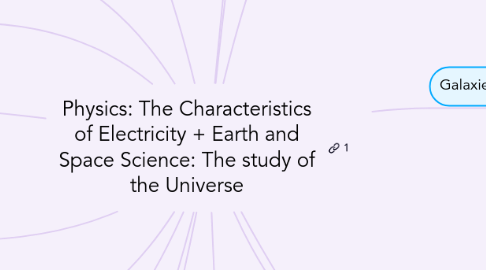Physics: The Characteristics of Electricity + Earth and Space Science: The study of the Universe
af Kharish Pratheesh


1. Static Electricity
1.1. Electric Charges
1.2. Static Charge
1.3. Friction
1.4. Movement of electrons
1.5. Protons never move
1.6. Electrons move
1.7. Conductiosn
2. Current
2.1. Electrolyte
2.2. Electrodes
2.3. AC
2.4. DC
2.5. Measured with an ammeter
2.6. Unit is A (amphere)
3. Potential Difference
3.1. Also known as voltage
3.2. Measured with a Voltmeter
4. Resistance
4.1. Measured with an ohmmeter
4.2. Transfers current into other forms of energy
4.3. Factors affecting the resistance of a wire
5. Circuits
5.1. Series Circut
5.2. Parallel Circuit
5.3. Load, Switch, Wires, Energy source
6. Protons, Electrons, Neutrons
7. Laws of Attraction and Repulsion
7.1. Opposites attract
8. Charge
8.1. Charge by Contact
8.2. Charge by Induction
8.3. Charge by Friction
8.4. Grounding
9. Formulas
9.1. V=IR
9.2. I=V/R
9.3. R=V/I
9.4. Input/Output
10. Stars
10.1. Low Mass stars
10.2. Protostar
10.3. Medium Mass Stars
10.4. High Mass stars
10.5. Supernovas
10.6. Hertzsprung-Russell Diagram
11. Space Exploration
11.1. Spinoff Products
11.2. ISS
11.3. Space probes
11.4. Space Shuttle
11.5. Satelleites
11.6. Microgravity
11.6.1. Causes health issues
11.7. Many challenges with living in space
11.7.1. Radiation
11.7.2. Microgravity
11.7.3. Weightlessness
11.8. New and improved space suits
12. The Solar System
12.1. Light years
12.2. Astronomical Unit (AU)
12.3. Light years are longer than AU
12.4. Rocky Inner Planets
12.4.1. Mercury
12.4.2. Venus
12.4.3. Earth
12.4.4. Mars
12.5. Four Gaseous Outer Planets
12.5.1. Jupiter
12.5.2. Saturn
12.5.3. Uranus
12.5.4. Neptune
12.6. Minor planets
12.7. Comets and Meteors
13. Earth
13.1. Orbits the Sun
13.2. Rotates at 1670km/hour
13.3. Tilted axis
14. Moon
14.1. Phases move in counter clockwise direction
14.2. 8 Different phases
14.2.1. First quarter
14.2.2. waxing gibbous
14.2.3. full
14.2.4. waning gibbous
14.2.5. last quarter
14.2.6. waning cresent
14.2.7. new
14.2.8. waxing cresent
14.3. Lunar Eclipse
14.4. Affects tides on Earth
15. Sun
15.1. Six Layers
15.1.1. Core
15.1.2. Radiative Zone
15.1.3. Convective Zone
15.1.4. Photosphere
15.1.5. Chromosphere
15.1.6. Corona

